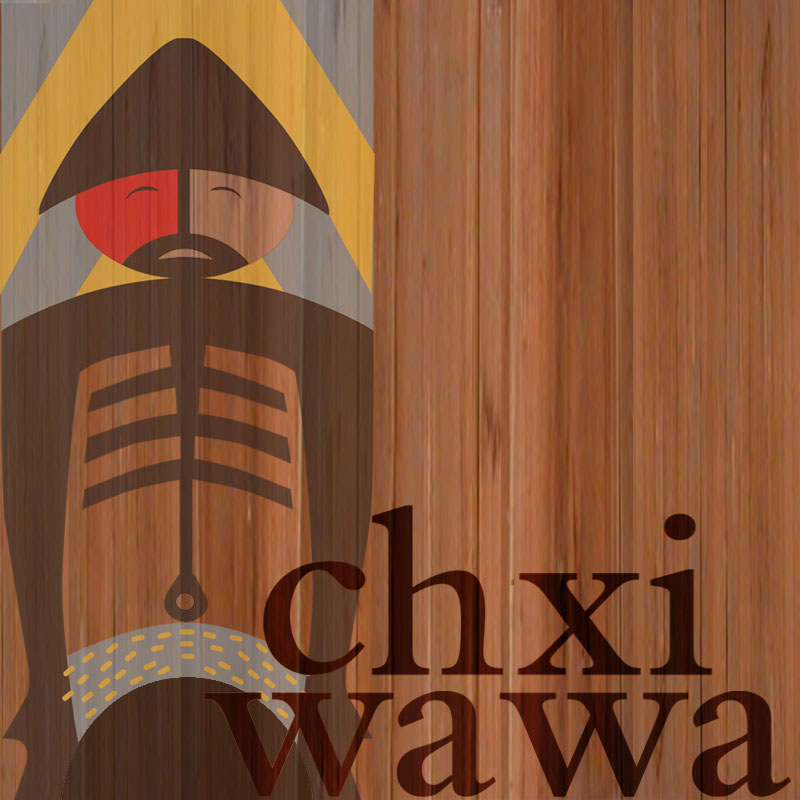By RILEY YUAN Chinook Observer
On a July afternoon, Brandi Ramus sits at the long table in the Chinook tribal office, surrounded by books. An array of sepia-toned faces smile up from the front cover of one. Beneath them, the title reads: Kakwa nsayka ulman-tilixam laska munk-kemteks nsayka — As our elders teach us to speak it.
A few weeks earlier, Ramus received a language revitalization fellowship from 7000 Languages, a Boston-based nonprofit. The paid, 10-week program offers technical training, pedagogical guidance and access to online platforms where the language learning materials she develops will eventually be hosted, free of charge.
That language is Chinuk Wawa, an endangered creole of Chinookan, French, English and various other Native and non-native languages. When Ramus started learning it a few years ago, she was still living in Iowa — the state where she grew up and where much of her extended family still lives. Now, Ramus lives in Naselle, where she and her partner bought a house in January. When she isn’t working on the language, she serves as the tribe’s community outreach coordinator.
Tribal council chairman Tony Johnson walks into the room, and Ramus takes the opportunity to ask for an expert opinion. She points to two flash cards with color swatches on them — one green and one blue.
“Do you like típsu-pchíx̣ or kúsax̣-pchíx̣? Or would you prefer pchíx̣?” “I think you teach pchíx̣ first. I mean, it’s my opinion—”
“—and then break it up later?”
They are discussing how to teach the Chinuk Wawa word for “blue,” which is also the word for “green” — a demonstration, given the local color palette, of the language’s deep connection to place.
Chasing knowledge
The variation of Chinuk Wawa that Johnson and Ramus speak derives a little over half of its vocabulary from Old Chinook. It likely originated as a pidgin language that the Chinook peoples used to communicate with neighboring tribes.
Then came the Europeans and with them, a cross-continental fur trade that transformed the language into the region’s lingua franca of intertribal and interethnic communication. Chinuk Wawa was spoken from canneries to courtrooms, by white missionaries and Chinese dockworkers alike. It borrowed words from languages as disparate as Hawaiian and Michif — the language of the Metis people who arrived with the Hudson’s Bay Company. It gave countless places names that are deeply familiar on the Northwestern tongue: skookum, tyee, tillicum, illahi, and of course, chinook. By the turn of the 20th century, hundreds of thousands of people, from Southeast Alaska to Northern California, spoke some form of Chinuk Wawa.
A century later, that number had plunged to about a dozen, as government-funded boarding schools and other assimilationist policies suppressed — often violently — native languages and culture. It was these remaining elders that Johnson learned from throughout the late 1990s.
“I was just chasing people who knew Chinuk Wawa,” he explains.
In the early aughts, Johnson helped start the Chinuk Wawa immersion program at Grand Ronde and also co-taught the inaugural courses of the Chinuk Wawa Language Program at Lane Community College in Eugene. The book that sat on the table in front of Ramus — As our elders teach us to speak it — is a 400-page dictionary of the language that Johnson helped compile.
Over the past two decades, initiatives like these haven’t just helped Chinuk Wawa claw its way back from the brink of extinction. They’ve produced a critical mass of new speakers that is showing signs, to those within it, of becoming self-sustaining.
“It feels like we’re just at this inflection point,” says Carisa Chang, a Seattle-based Chinook tribal member who studied Chinuk Wawa at LCC alongside Ramus and will begin teaching the program’s second-year course herself this fall. “There’s finally starting to be enough of us that it feels like we’re going to hit a flywheel.
Grand Ronde connection
One reason why Johnson did the bulk of his early language work at Grand Ronde is that there had been a historical concentration of Chinuk Wawa speakers there. When the 30-plus constituent tribes of the Confederated Tribes of Grand Ronde were initially forced together onto the same reservation, they spoke a variety of different languages and dialects.
Chinuk Wawa became their common tongue, as in precolonial times.
Another reason is that Grand Ronde had what the Chinook Indian Nation, to this day, doesn’t: federal recognition. And with that, the resources to support cultural programming.
“My interest in the fight for federal recognition,” says Johnson, “is pretty much expressly to ensure that we have the strongest possible future for this work — for our language and cultural revitalization work.”
Which is not to say that the revitalization of Chinuk Wawa depends on governmental or institutional support. Money and facilities are vital, but Chinook culture survives and thrives primarily because of the pride and resilience of Chinook people — because of their insistence on keeping their language, stories and customs alive at home.
Tribal council member Rachel Cushman has spoken Chinuk Wawa with her children since they were born.
“There are folks who find it very, very important and have sustained it — who never let it go,” she says. “I just want to say that very clearly — the language has never disappeared.”
But in other households, adults and children may be learning the language together. For some, a college-level course like LCC’s could be too intimidating. Or it might simply be too far away. For others, the classroom may not be a safe or neutral space to begin with, especially given the history of Indian boarding schools. And still others have learning styles and needs that traditional pedagogical methods don’t readily accommodate.
Accessibility of language and cultural programs is key. Which is why Ramus asks her fellow tribal members every chance she gets:
“What’s stopping you from learning [Chinuk Wawa]?”
The conversations have reminded her, for instance, of the need to take dyslexia and other learning difficulties into account:
“I don’t want this learning of Chinuk Wawa to be hinged on having a good grasp of the English language first,” Ramus explains. “So I have backed up and I am making this curriculum suitable, I believe, for… a five- to 10-year-old, and I am using a lot more visuals and audio.”
Other tribal members are working to ensure that a lack of proficiency in Chinuk Wawa doesn’t keep a wider swath of Chinook people from appreciating traditional stories known as ikanum.
Rachel Kidd is a Chinook tribal member who serves on the American Indian Languages Program Committee at LCC, and Quinne Larsen is a Chinook animator, writer and musician based in Los Angeles. In the wintertime — the only time when ikanum can be told — the pair facilitates a weekly reading and discussion group on
Zoom, modeled after a similar, year-round group led by Grand Ronde-affiliated linguist Jedd Schrock. Only in Kidd’s and Larsen’s group, the stories are translated and read in English.
“Our goal is to create a bigger and bigger and bigger cohort of people who know the language and know the stories,” says Kidd.
“Everyone needs to have access,” adds Larsen. “This has to happen in community.”
Language is identity
As Ramus tells it, even her siblings in Iowa initially questioned the “practicality” of her decision to start learning Chinuk Wawa.
But language revitalization isn’t some abstract, intellectual pursuit. There’s far more at stake. Language is identity. Its deliberate erasure, as experts agree, is a form of cultural genocide.
“The language is the culture, is the people, is the land,” Larsen explains. “Those are not separate concepts, and those are not metaphors. That is the relationship. They are all the same thing.”
This can be a difficult concept to grasp in a Western, capitalistic society. But for many Chinook people, it instills a profound — even spiritual — sense of place. It explains why for Ramus, speaking Chinuk Wawa, going for a walk around her property, and simply being around other Chinook people have all come to produce the same feelings: calm, peace, and belonging.
“It almost sounds unbelievable,” she acknowledges. “But I recognized Chinuk Wawa, in a way. I’d never learned it before, but I felt at home in learning it. I felt a connection that I can’t say I have felt when learning other languages.”
Getting to this point wasn’t easy. In one of her many manila folders brimming with documents, Ramus keeps a piece of paper on which her mother had scribbled names, phone numbers, addresses and a few fragments of questions. This is what remains of her own search for answers about the family’s ancestry — a search that was hindered by both circumstance and design.
Ramus’s mother was raised in Iowa too. Her Chinook father ultimately returned to the West Coast, but not before regaling his daughter with stories about their native heritage. Her Midwestern mother, on the other hand, was openly hostile to whatever curiosities these stories might have awakened.
“My mother battled people telling her she wasn’t who she felt she was,” Ramus recalls. “Whether that was the native part of her or a good mom, she always had people… that she had to battle against to prove her worth and validity.”
Ramus had to fight a similar battle, albeit against herself. Reconnecting with her heritage after several generations and a thousand miles-worth of separation forced her to wrestle with the shame and doubt surrounding her own sense of identity. But it also provided catharsis and healing that she didn’t even know she needed.
“I didn’t know I would feel so at home here,” she said. “I didn’t know I was going to feel this connection with this side of my family. I didn’t know that. It just happened. I got here and I realized I could never leave.”
“For a lot of us, language can be this hole that we’ve had our whole lives,” Larsen adds.
And that’s what drives Ramus’s and other language-keepers’ efforts to revitalize Chinuk Wawa: the chance to give any Chinook person who feels the effects of that hole a way to fill it.
The chance to bring not just a language home, but its people too.
Read the original story here








